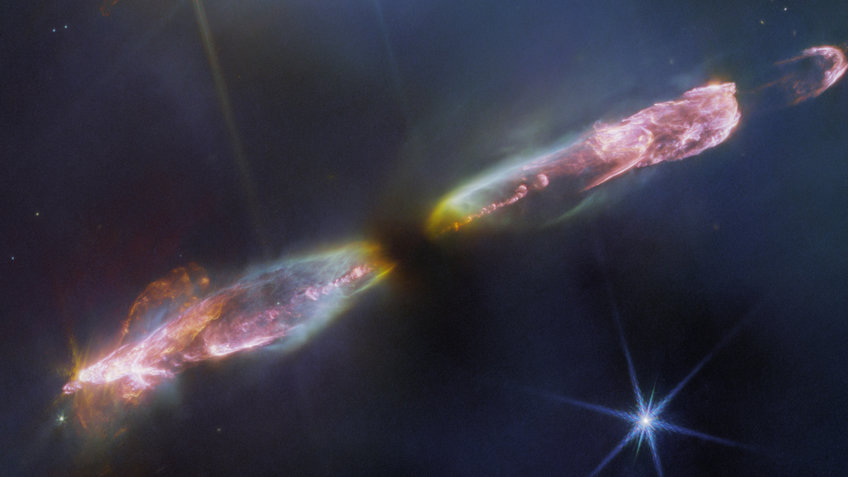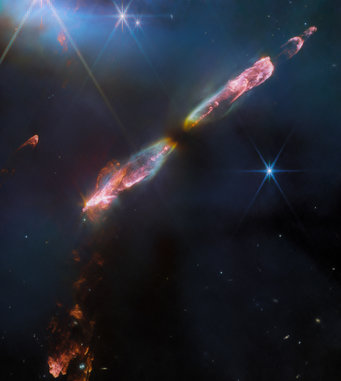Hiccups in the starry nursery
James Webb Space Telescope photographs the rearing of a stellar embryo
Before the light comes on and a new star shines, enough gas and dust must accumulate in a very small space for a star's energy source, nuclear fusion, to ignite. This by no means happens at rest. Matter swirls around, and before the star sees the light of day, violent birth labour is not uncommon. The new James Webb Space Telescope has turned its lens on such a spectacle, which reveals itself in unprecedented detail.

An international team, including researchers from the Max Planck Institute for Astronomy, recently captured a spectacular image of the so-called Herbig-Haro object HH211 in infrared light with the James Webb Space Telescope. The object can be found in direction of the constellation Perseus and consists of two opposing streams (or jets) of gas spewing from a baby star in the centre that is still covered in its cradle. HH211 is only about 1,000 light years from Earth, making it an ideal target for the space telescope. Gas streams of this type emit light on their own and can be traced back to stellar embryos - or protostars - growing in the middle of a dense molecular cloud. The stellar progenitor of HH211 is an infantile analogue of our Sun. While the expected lifetime of a star similar to the Sun is about ten billion years, HH211 is only a few tens of thousands of years old and has only 8 per cent of the mass of the Sun.
The magnificent appearance of Herbig-Haro objects like HH211 is due to a physical effect. Gas ejected outwards from the turbulent centre of the star's birth collides with gas and dust in the surrounding area, forming shock waves, and triggering radiation. A closer look at the corkscrew-like tracks of the inner gas jet suggests that not one, but two stars are being born at the centre, orbiting each other.
"Such observations with the JWST not only provide stunning images," says Thomas Henning, director at the Max Planck Institute for Astronomy in Heidelberg. "The observations generate invaluable information in our quest to understand star formation." Newborn stars and their outflows are not easy to spot in visible light because they are still embedded in the dense cloud of gas and dust from which they are forming. However, the James Webb Telescope observes the infrared light emitted by the gas jets, which can penetrate the obscuring gas and dust. More specifically, it is molecules such as hydrogen, carbon monoxide and silicon monoxide that are excited by the turbulent conditions, emitting infrared light at characteristic wavelengths. The image from the space telescope is also a superposition of these light sources, allowing the researchers to map the structure of the outflows.

The team also measured the wavelengths of light emitted by excited hydrogen and carbon monoxide in the large bow shock waves at the end of the jets, as well as by silicon oxide from the jet itself. As expected, these wavelengths deviate from the standard wavelengths that the gas would emit in its resting state. The shift in wavelengths is explained by the Doppler effect and is comparable to a police car whose siren changes pitch as it moves towards and then away from a person. In the case of HH211, the researchers use this effect to measure a velocity of the gas streams that, at 80 to 100 kilometres per second (about 300,000 kilometres per hour), is relatively slow compared to other systems where the protostars are more advanced. The speed of the bow wave at the end of the jets, i.e. where the jet collides with surrounding material, is much lower still. This is a direct indication that the upstream material in the case of this still very young system consists mainly of molecules. The speed of the shock waves is still too low to break the molecules apart. Yet, this will likely change with the increasing age of the protostar.
MN/TB













